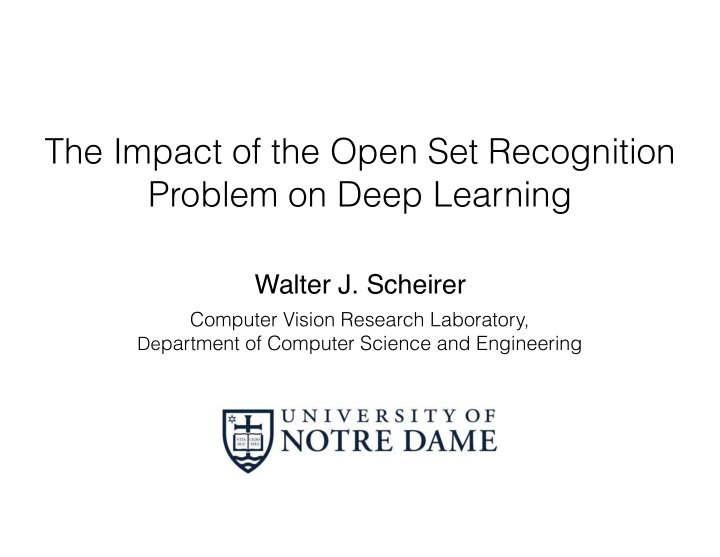



The Impact of the Open Set Recognition Problem on Deep Learning Walter J. Scheirer Computer Vision Research Laboratory, De partment of Computer Science and Engineering
Benchmarks in computer vision Assume we have examples from all classes: Campsite Gas Station Airfield Water Park Mountain Places2 Data Set (part of ILSVRC 2016)
Out in the real world… Detect the cars in this image while rejecting the trees, signs, telephone poles… M. Milford, W.J. Scheirer, E. Vig, A. Glover, O. Baumann, J. Mattingley, and D.D. Cox, “Condition Invariant Top-Down Visual Place Recognition,” ICRA 2014.
Open Set Recognition : incomplete knowledge of the world is present at training time, and unknown classes can be submitted to an algorithm during its operation.
“There are known knowns…” known classes: the classes with distinctly labeled positive training examples (also serving as negative examples for other known classes) known unknown classes : labeled negative examples, not necessarily grouped into meaningful categories unknown unknown classes: classes unseen in training
Vision problems in order of “openness” W. J. Scheirer, A. Rocha, A. Sapkota, and T. Boult, “Towards Open Set Recognition,” IEEE T-PAMI, 35(7) July 2013.
Fundamental multi-class recognition problem ⇢ � Z argmin R I ( f ) := L ( x, y, f ( x )) P ( x, y ) f R d × N Ideal Risk Loss Function Joint Distribution Undefined for open set recognition! A. Smola, “Learning with Kernels,” Ph.D. dissertation, Technische Universität Berlin, Berlin, Germany, November 1998.
Open Space Negatives Positives ? ? ? ?
Open Set MNIST Benchmark Training images Testing images Closed set testing on MNIST of digits (0-5) Open set testing on MNIST of digits (0-9) 1$ 1$ 0.85$ 0.85$ Accuracy Accuracy 0.7$ 0.7$ P I -SVM Proposed Approach 1-vs-Rest SVM 1-vs-Rest SVM w/ Threshold 0.55$ 0.55$ (6,6)$ (7,7)$ (8,8)$ (9,9)$ (10,10)$ (6,6)$ (6,7)$ (6,8)$ (6,9)$ (6,10)$ (##training#classes,###tes/ng#classes)# (##training#classes,###tes/ng#classes)# (a) (b) (c) (d) L. P. Jain, W. J. Scheirer, and T. Boult, “Multi-Class Open Set Recognition Using Probability of Inclusion,” ECCV 2014.
“Tangled” 10 Adapted from an image by D. D. Cox
“Untangled” 11
Linear separation of CNN feature representations unknown individual individual 2 individual 2 (”Joe”) (”Joe”) ineffective separating separating hyperplane hyperplane individual 1 unknown (”Sam”) individual 1 individual (”Sam”) 12 Female head #10 CC BY 2.0 Turinboy Female head #3 CC BY 2.0 Turinboy
Read-out layer ? Typical CNN architecture CC BY 4.0 Aphex34 Softmax Linear SVM Cosine Similarity A · B || A || || B || < δ subject to Threshold determined Sum over all of the classes Known positive or empirically via known negative sample pairs
Evolving images to match CNN classes A. Nguyen, J. Yosinski, and J. Clune, “Deep Neural Networks are Easily Fooled,” CVPR 2015.
A step towards a fix: OpenMax A. Bendale and T. Boult, “Towards Open Set Deep Networks,” CVPR 2016.
How does OpenMax work? Apply probability models derived from statistical extreme value theory to calculate class weights Use weights to adjust activation Apply rejection threshold
But you don’t have to use tricky manipulations GoogleNet Output Label: Hammerhead Label: Blow Dryer Label: Mosque Shark Label: Syringe Label: Trimaran Label: Missile
Are performance measures misleading us?
Psychophysics on the Model N = 427 Google Picasa Human performance* Accuracy Facebook, mixed occluders Facebook, solid occluders Face Signal W.J. Scheirer, S. Anthony, K. Nakayama, and D. D. Cox, “Perceptual Annotation: Measuring Human Vision to Improve Computer Vision,” IEEE T-PAMI, 36(8) August 2014.
Psychophysics pipeline 1. Render Class 2. CCV Classifier 3. Manipulate Chosen Canonical View (CCV) Variable Candidates 5. Generate 4. Classify Images Psychometric Curve Fish Accuracy Plane Skyscraper Brandon Area Visible RichardWebster
Practical implications http://goo.gl/78fglb
Thank you! Read more: www.wjscheirer.com
Recommend
More recommend